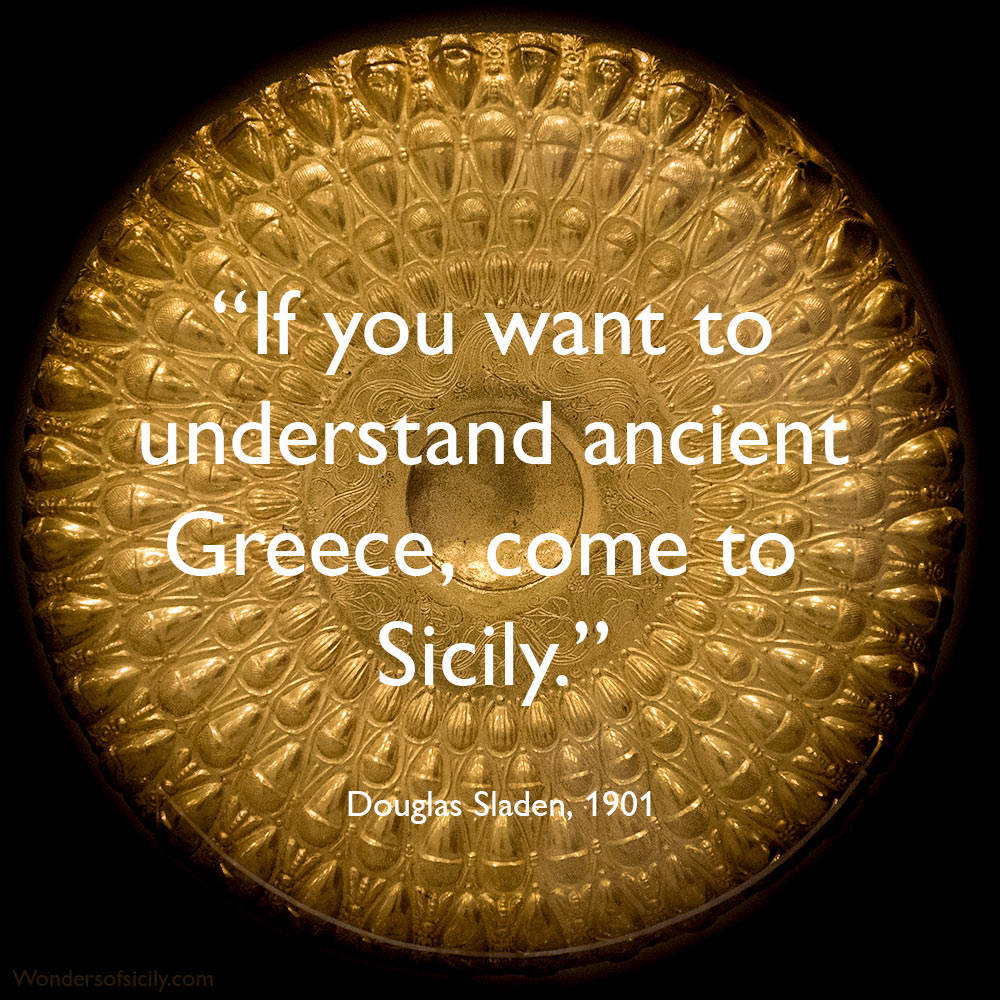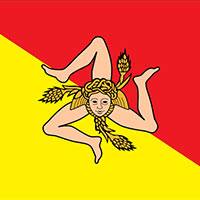Museo Archeologico Regionale Antonino Salinas:
The Archeological Museum in Palermo
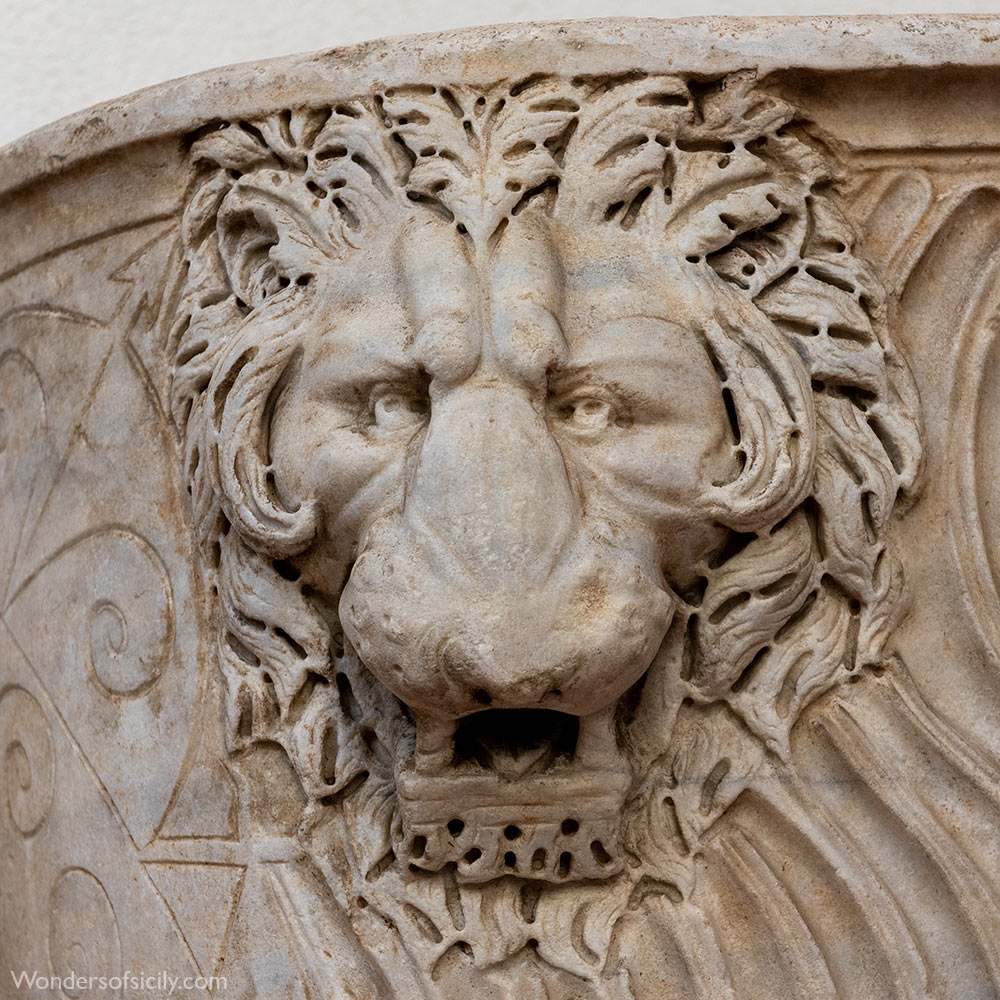
Lion on a marble sarcophagus (240-250 AD) in the form of a grape treading tank (lenòs).
The Museum
The Antonino Salinas Regional Archaeological Museum, located in Palermo, Italy, houses a remarkable collection of Punic and Ancient Greek art, making it one of Italy's most significant repositories of such artifacts. Additionally, the museum boasts numerous historical items pertaining to the region's history. Antonino Salinas, a renowned archaeologist and numismatist from Palermo, served as its director from 1873 until his demise in 1914. At his death, Salinas bequeathed his extensive private collection to the museum.
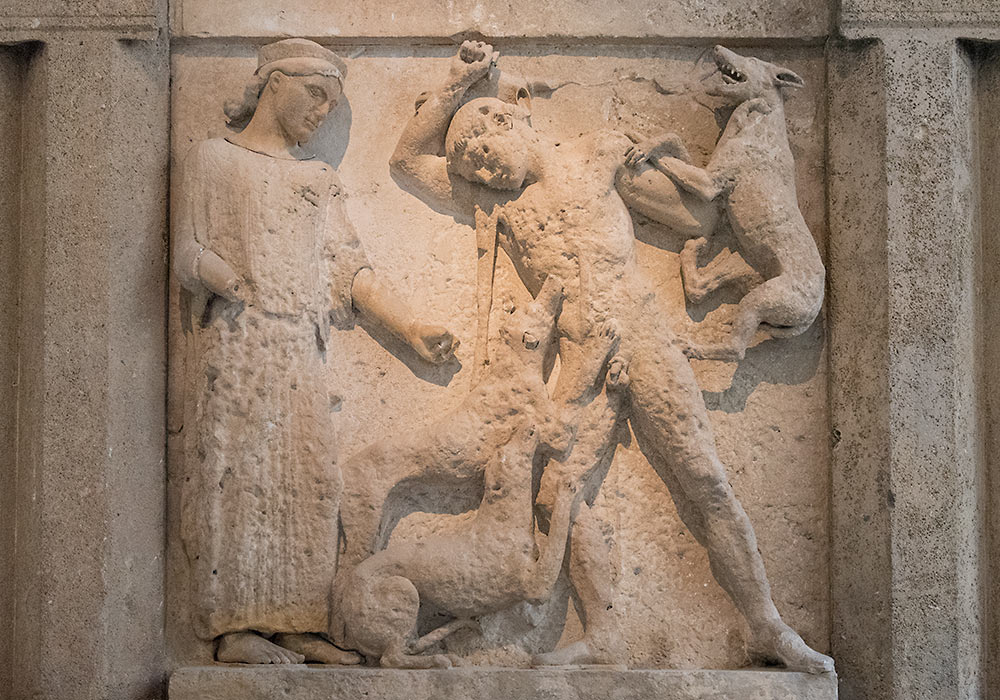
Actaeon is torn to pieces by dogs as punishment for having seen Artemis naked. Metope temple E (460-450 BC) Selinunte.
Among the notable exhibits is a reconstruction of the east pediment of the archaeological site of Selinunte, featuring the Gorgon of Temple C, several metopes with mythological reliefs from Temples C and E, and sculptures from the archaic and classical periods. The metopes were discovered in the early 19th century by British architects Samuel Angell and William Harris during their excavation work at Selinunte. Despite initial resistance from local authorities, the artifacts ended up in Palermo instead of the British Museum.
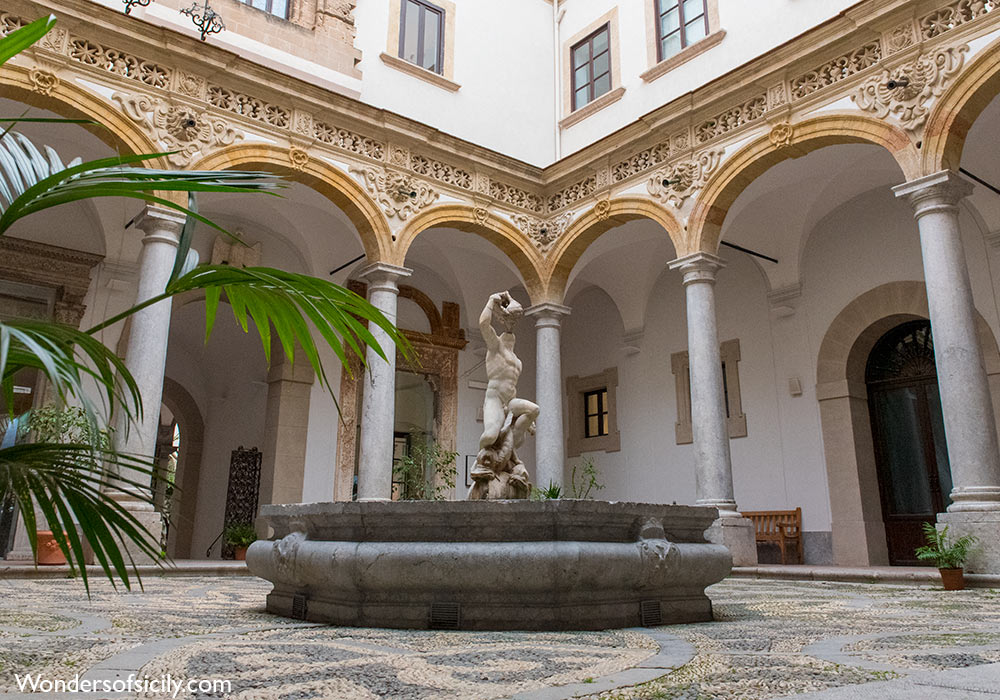
The museum is situated within the Olivella monumental complex, which also includes the Church of Sant'Ignazio all'Olivella and the adjoining Oratory. The construction of the Olivella complex commenced in the late 16th century under the architect Antonio Muttone for the Oratory of Saint Philip Neri, and it was completed in the 17th century. However, due to the law on the suppression of religious orders in 1866, the building was confiscated and subsequently converted into the museum.
The museum showcases artifacts from various ancient sites, including Himera, Solunto, Megara Hyblaea, Tindari, Kamarina, and Agrigento. Noteworthy pieces include the impressive Ram bronze from the third century BC found in Syracuse, a Roman copy of a sculpture by Lysippus depicting Heracles capturing the Ceryneian Hind, and a Roman copy of a marble statue by Praxiteles portraying a satyr.
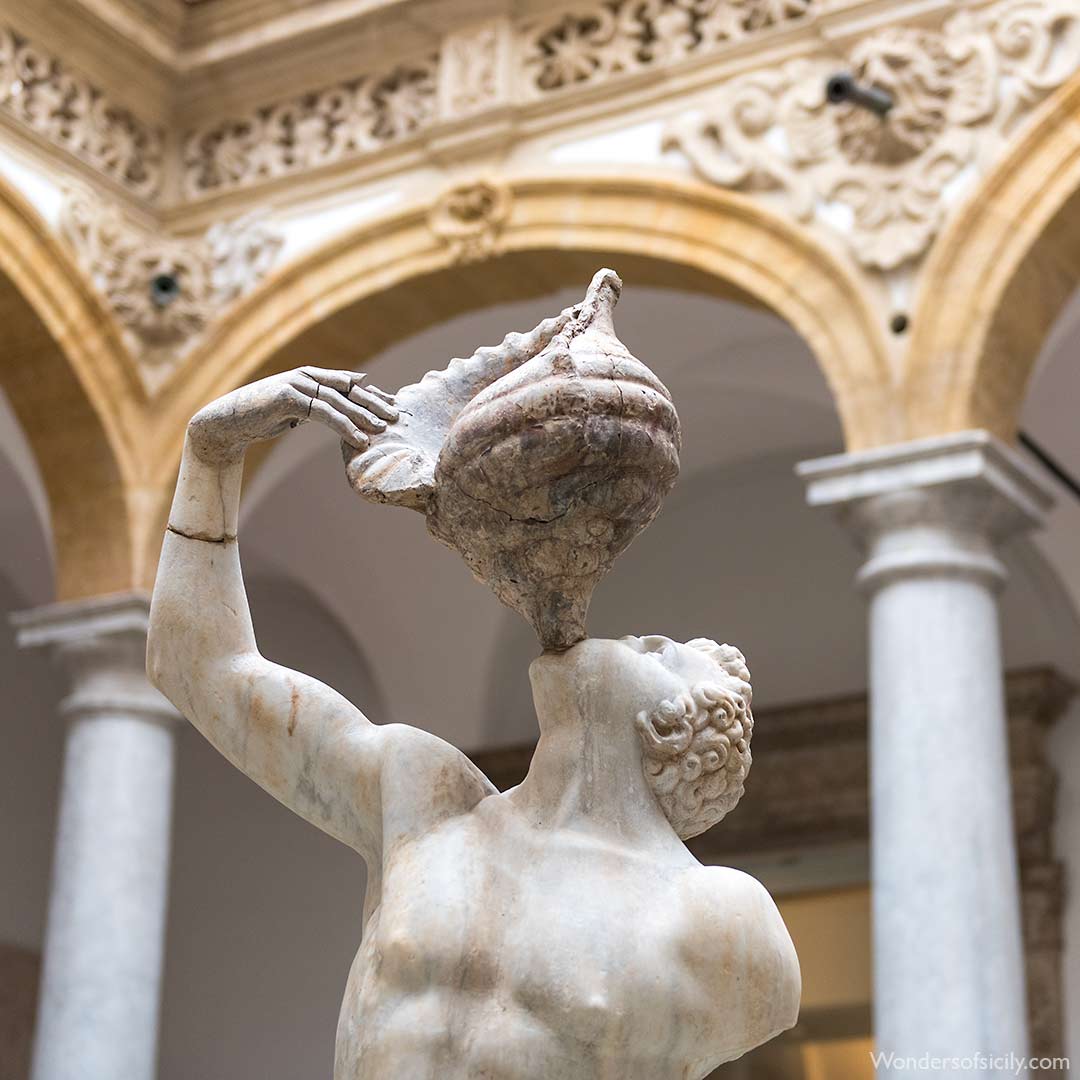
Detail of the fountain in the archeological museum in Palermo.
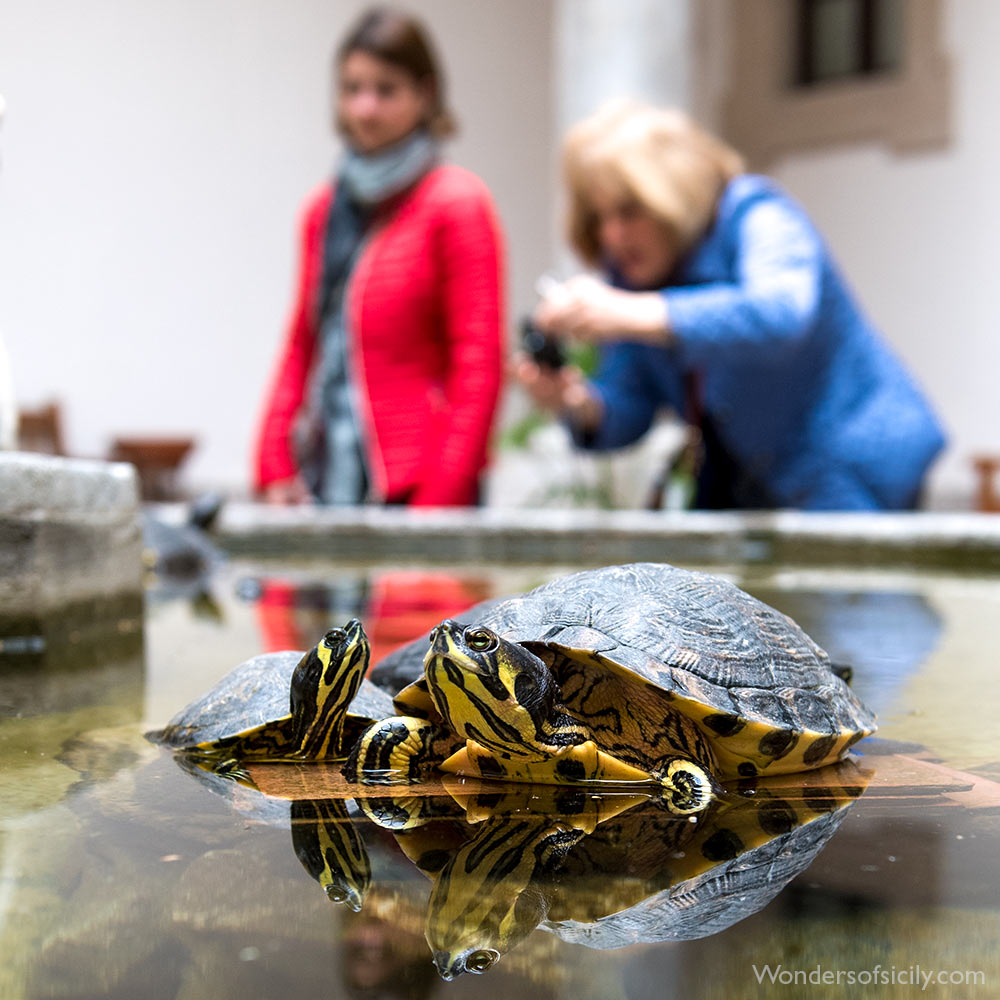
Turtles guarding the treasures at the magnificent archeological museum in Palermo.
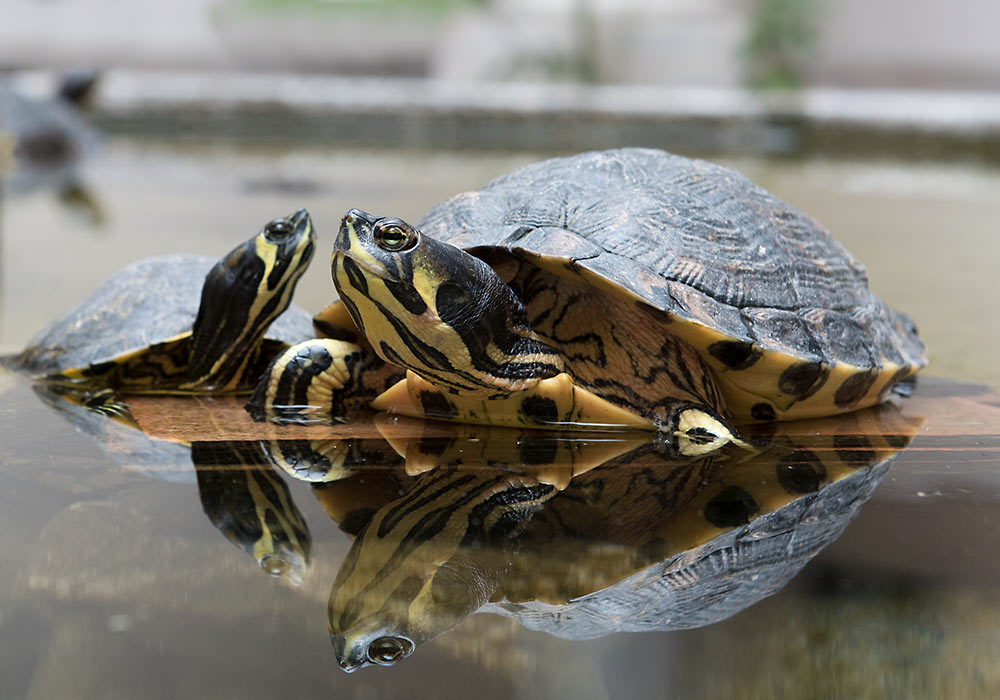
The charming turtles are oblivious to the devastating war in Ukraine as well as the other tragedies happening around in the world.
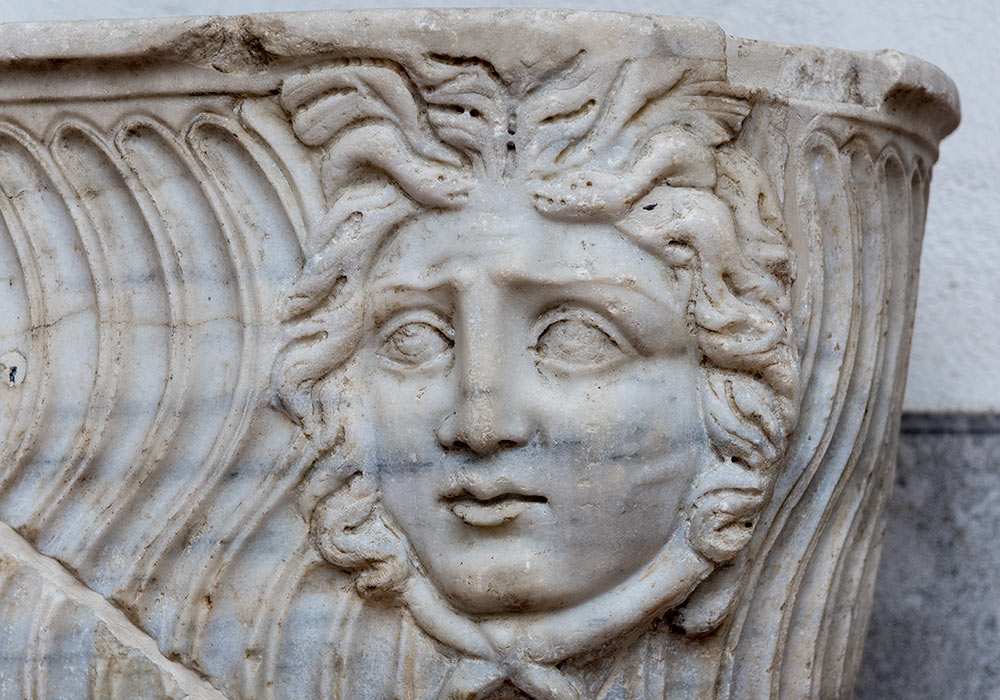
One of the two Medusa heads on a marble sarcophagus in the form of a grape treading tank (lenòs).
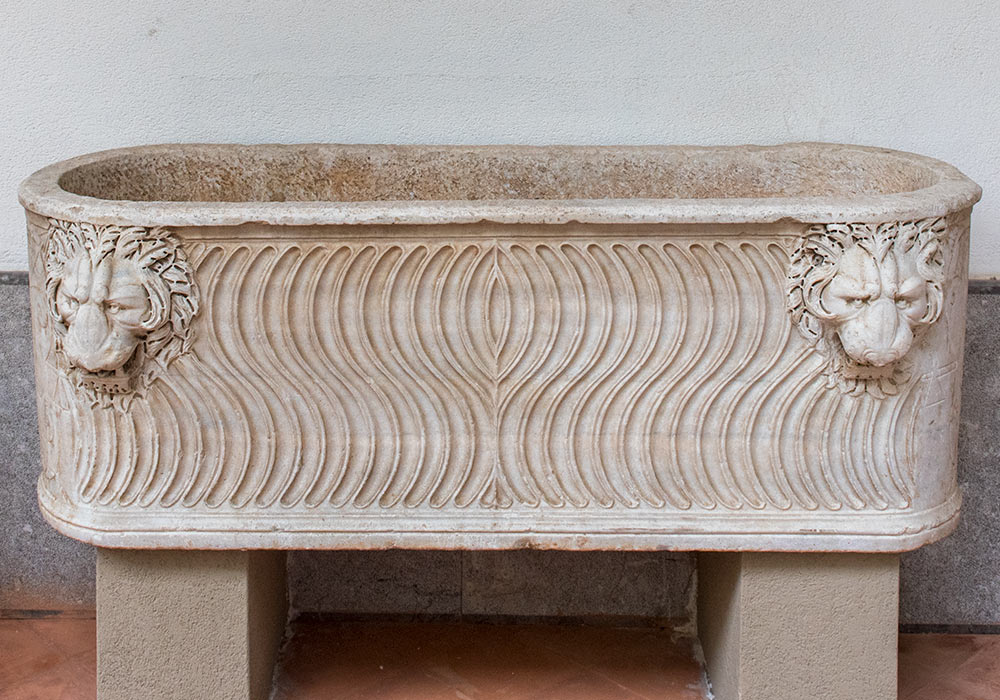
Lion heads on heads on a marble sarcophagus (240-250 AD) in the form of a grape treading tank (lenòs).
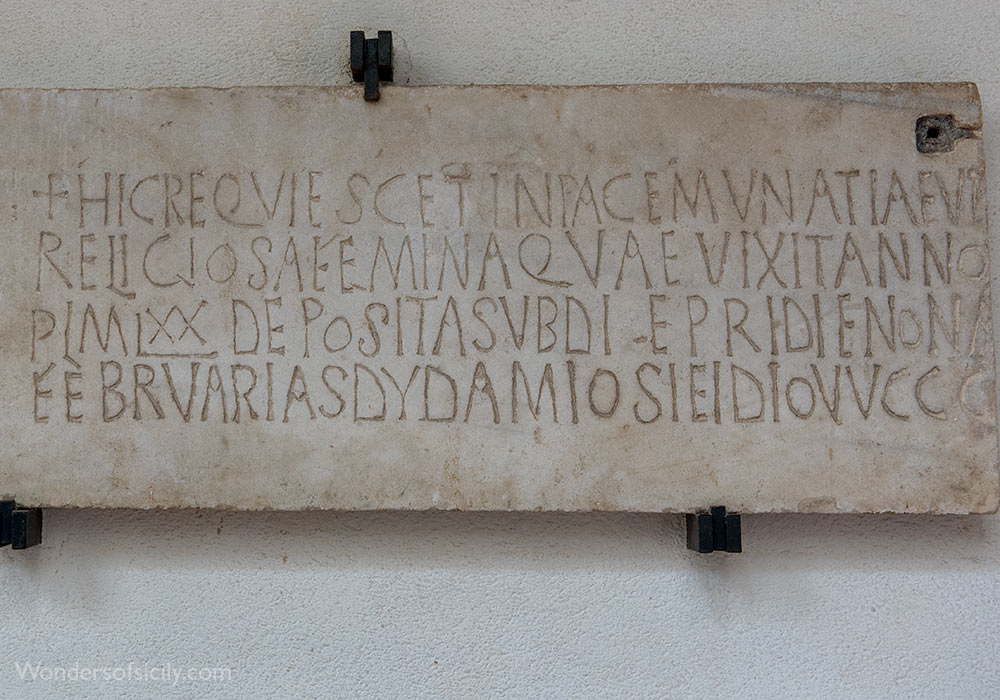
Marble fragment of a sarcophagus with funarary inscription. No date information.

Sarcophagus (c. 170 AD) with amazones, previously in Casa professa.
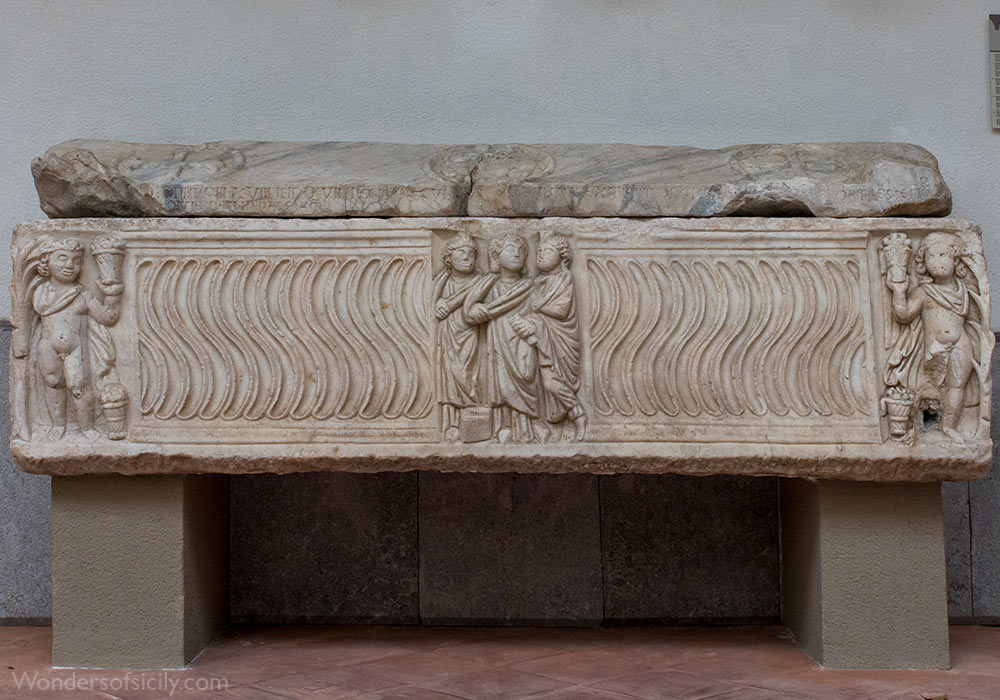
Roman sarcophagus (C2-C3 AD) reused in 1318 as a tomb for Nicola de Maida Sr. From the Convent of Sant’Agostino.
The Roman period is well-documented with a collection of sculptures and mosaics recovered from villas located in the former center of the Roman city, Piazza Vittoria in Palermo. Additionally, the museum features exhibits from prehistoric cultures found in the caves around the Palermo region.
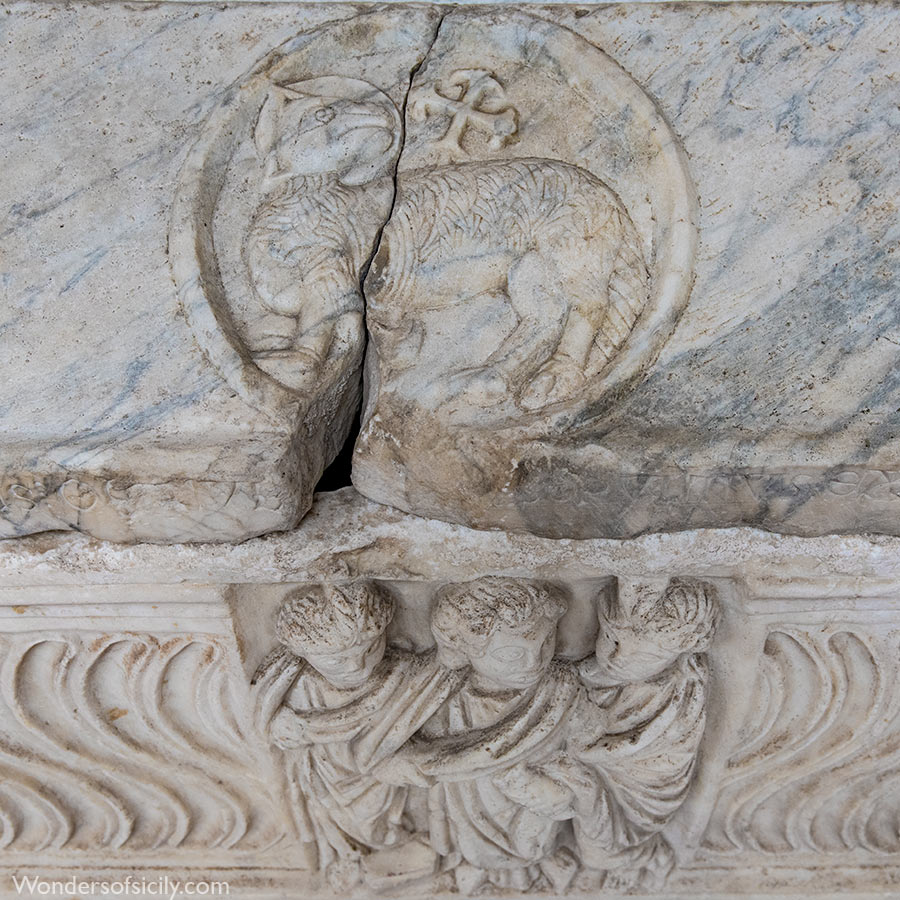
The lid of the Roman sarcophagus (C2-C3 AD) reused in 1318 as a tomb for Nicola de Maida Sr. From the Convent of Sant’Agostino. See above.
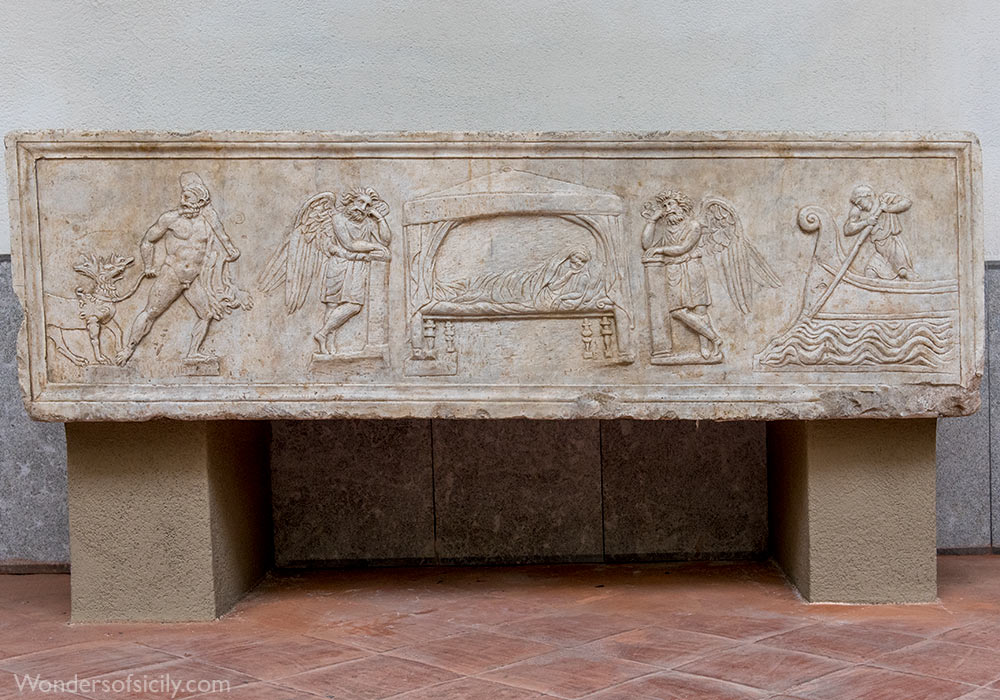
Marble sarcophagus of uncertain date showing Heracles and Charon. From the Convent of San Francesco d’Assisi.
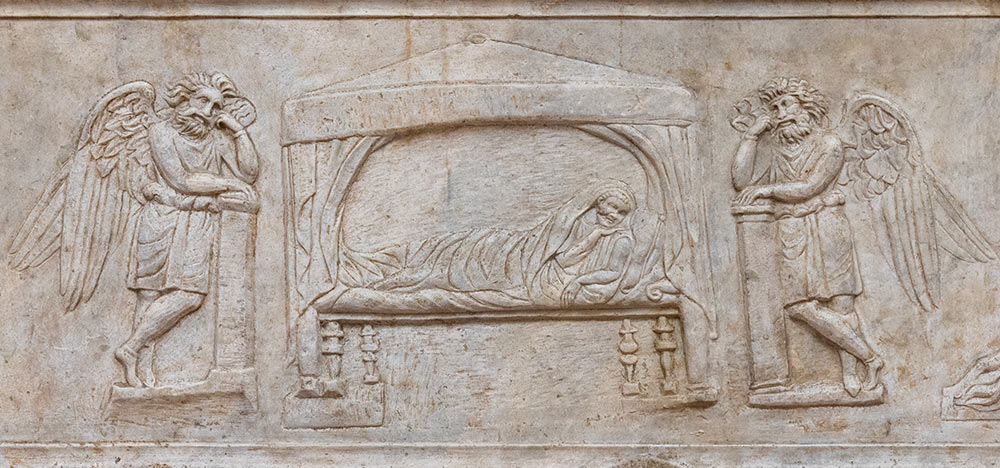
Detail of the sarcophagus above.
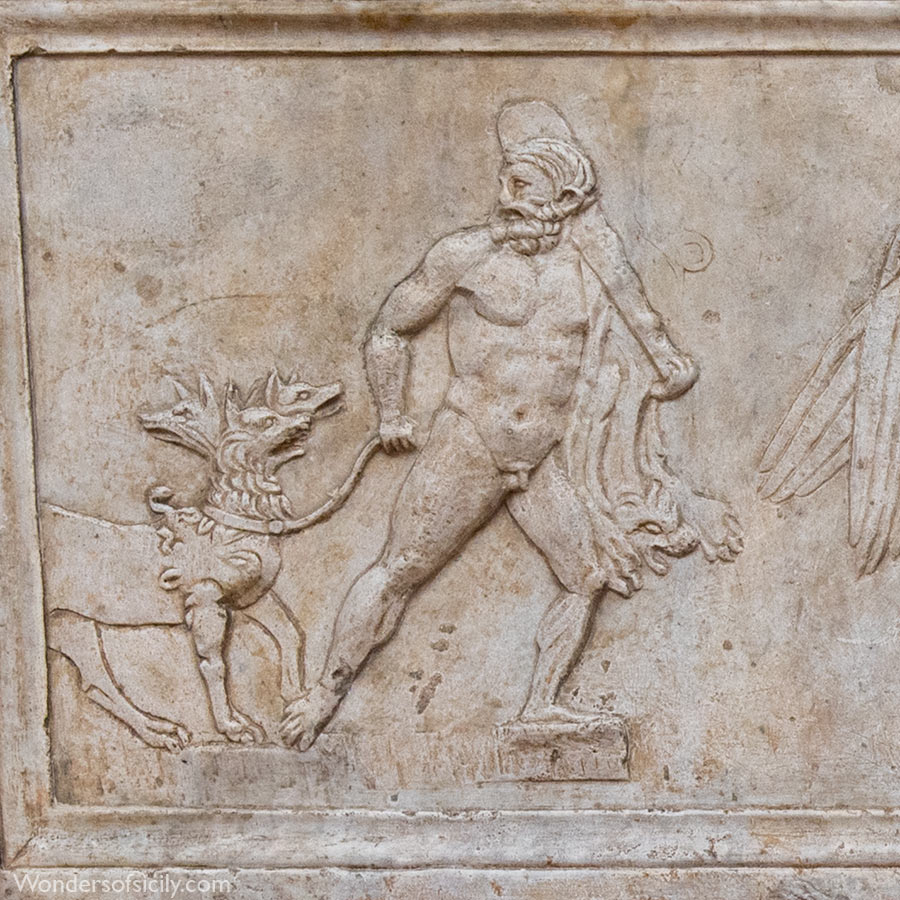
Detail of the undated sarcophagus above showing Heracles.
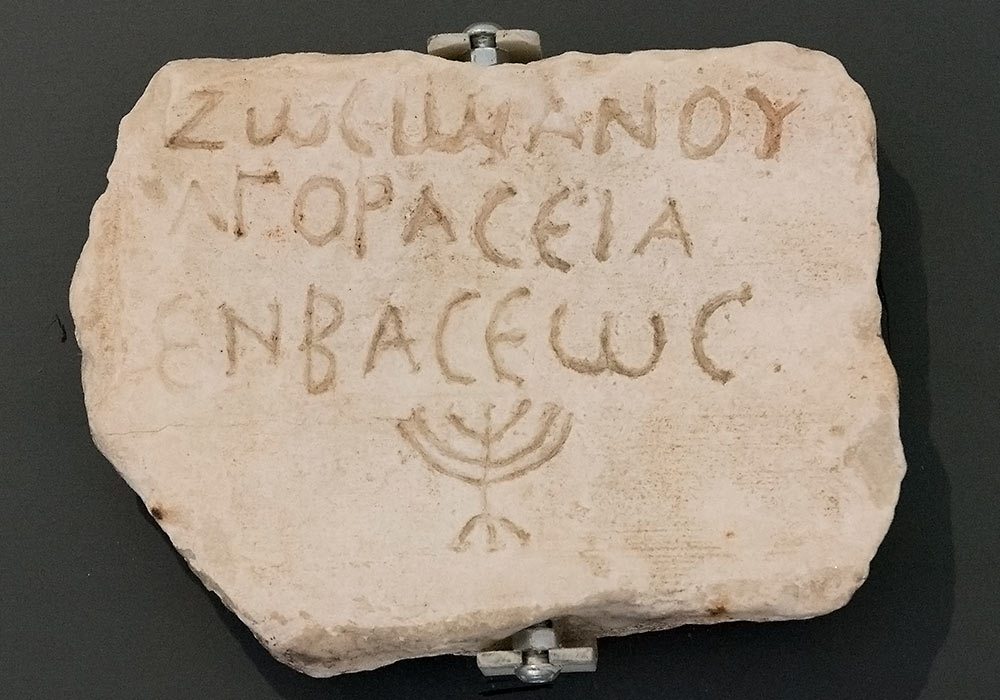
Marble slab with Hebrew funerary inscription (4-5th century AD), found in Catania. Now in the Archeological Museum, Palermo. The text above the seven-branched candelabrum reads: "Of Zosimaianos. Purchase of the tomb."
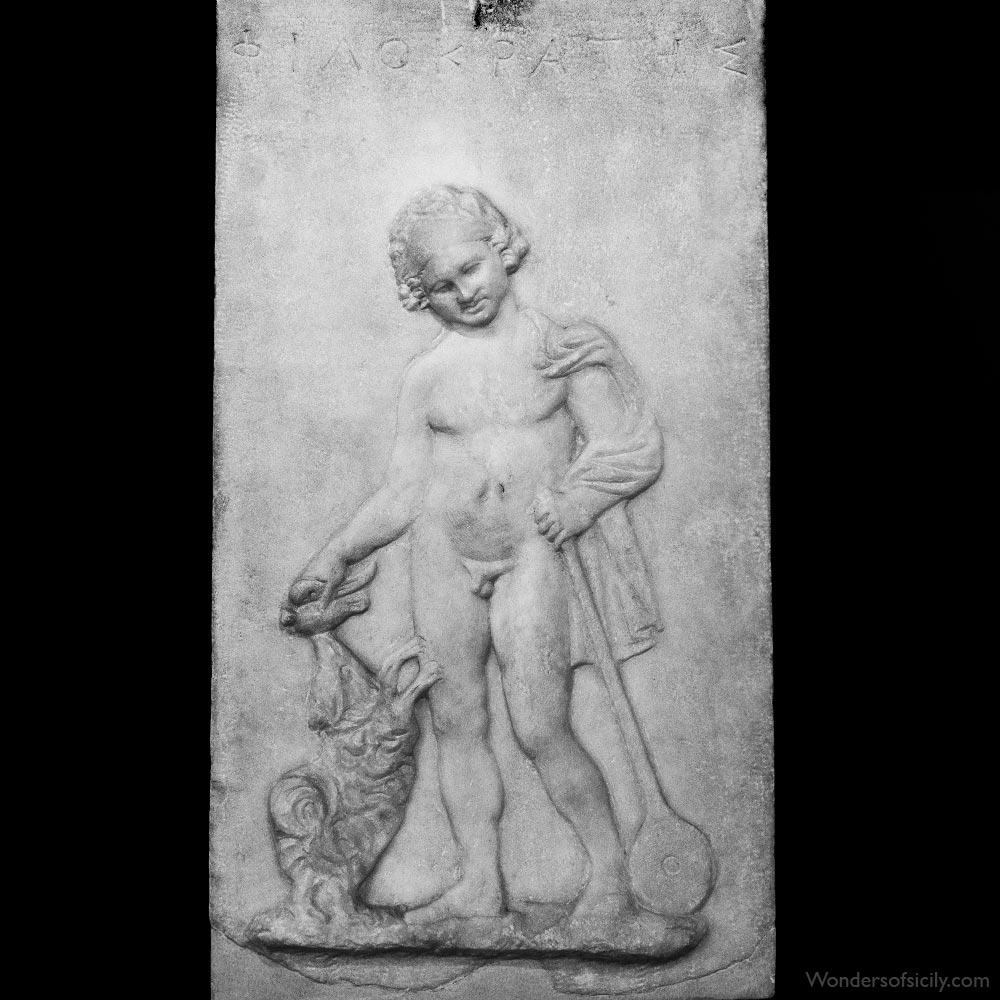
Funeral bas-relief depicting a boy with a dog and a bird, 250-300 A.D. At the top the name of the dead child "Philocrates" is incised.
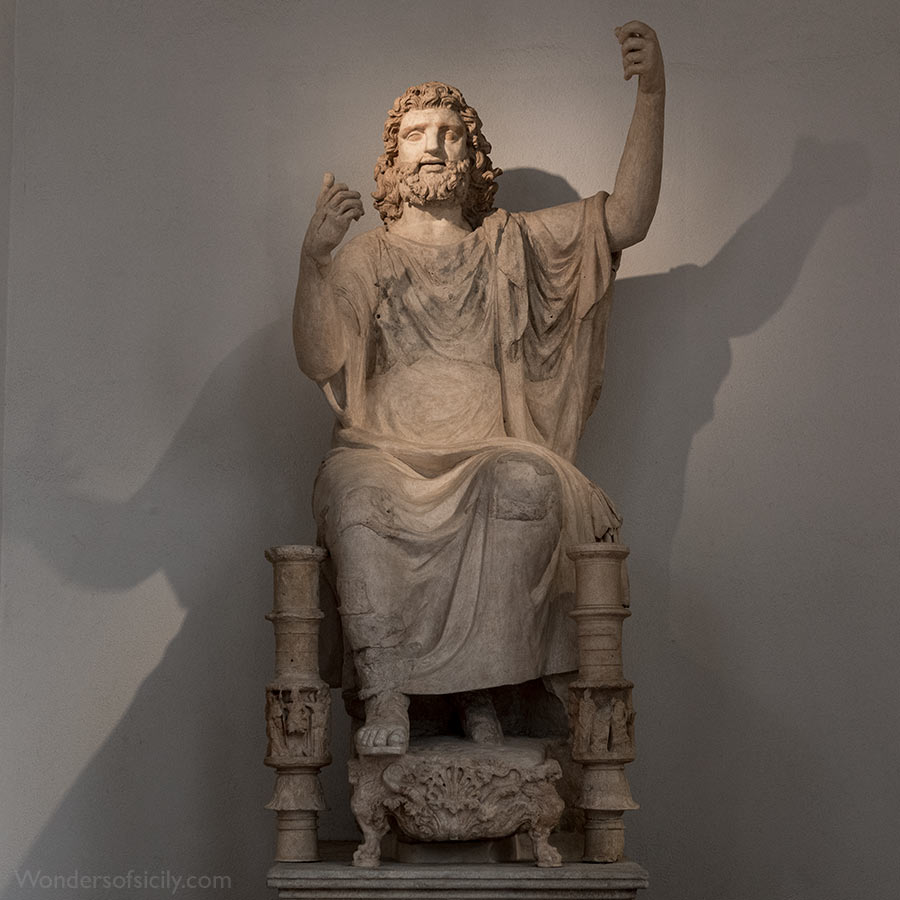
Monumental statue of Zeus. From Solunto.
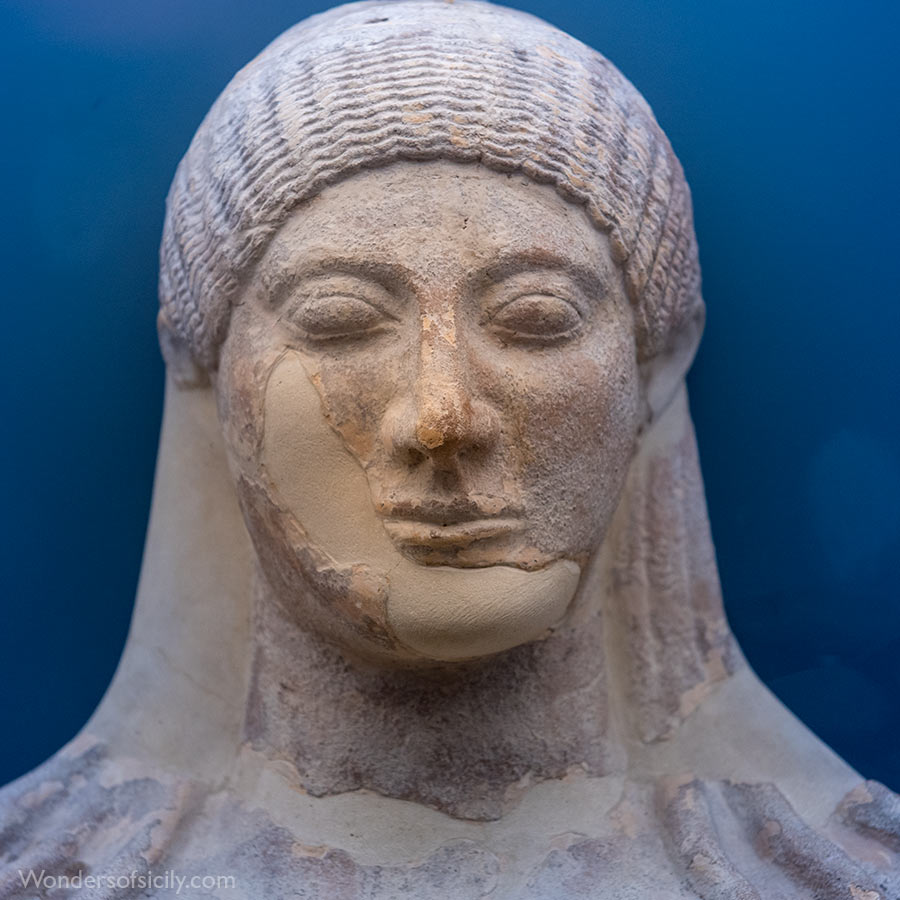
Votive bust from Selinunte. 5th century BC.
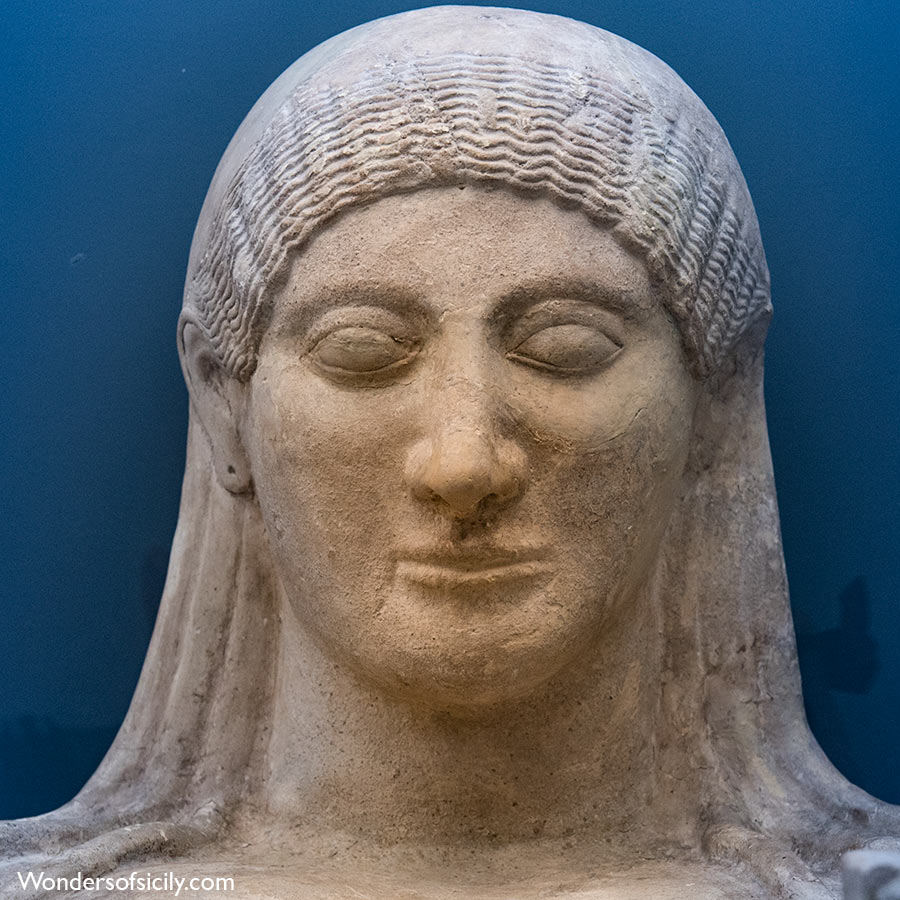
Votive bust from Selinunte. 5th century BC.
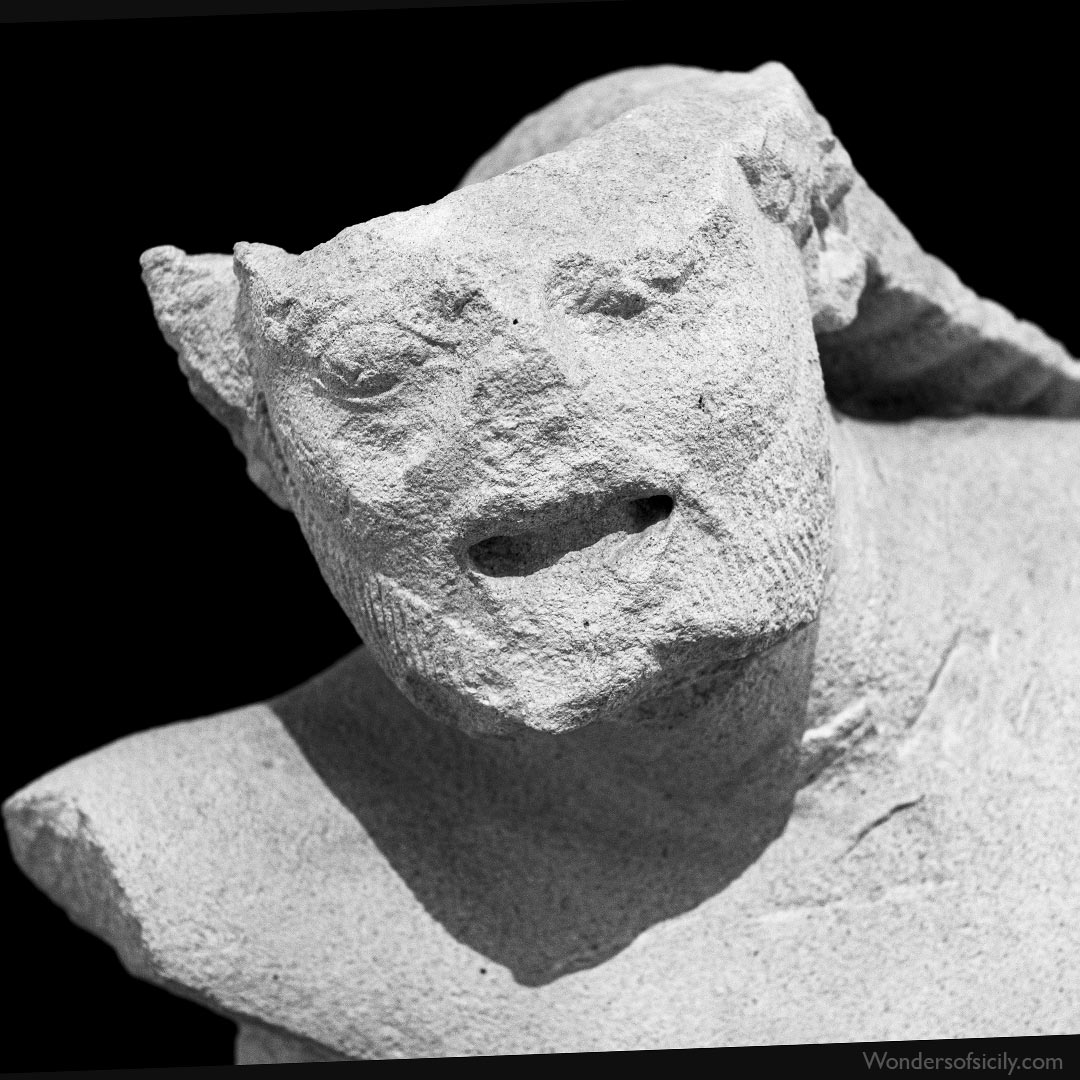
Detail of a torso portraying an overwhelmed giant with his mouth open in a grimace of pain. The sculpture was made of Menfi limestone. It was intended for architectural or votive purposes, according to the information given by the Archeological Museum in Palermo.
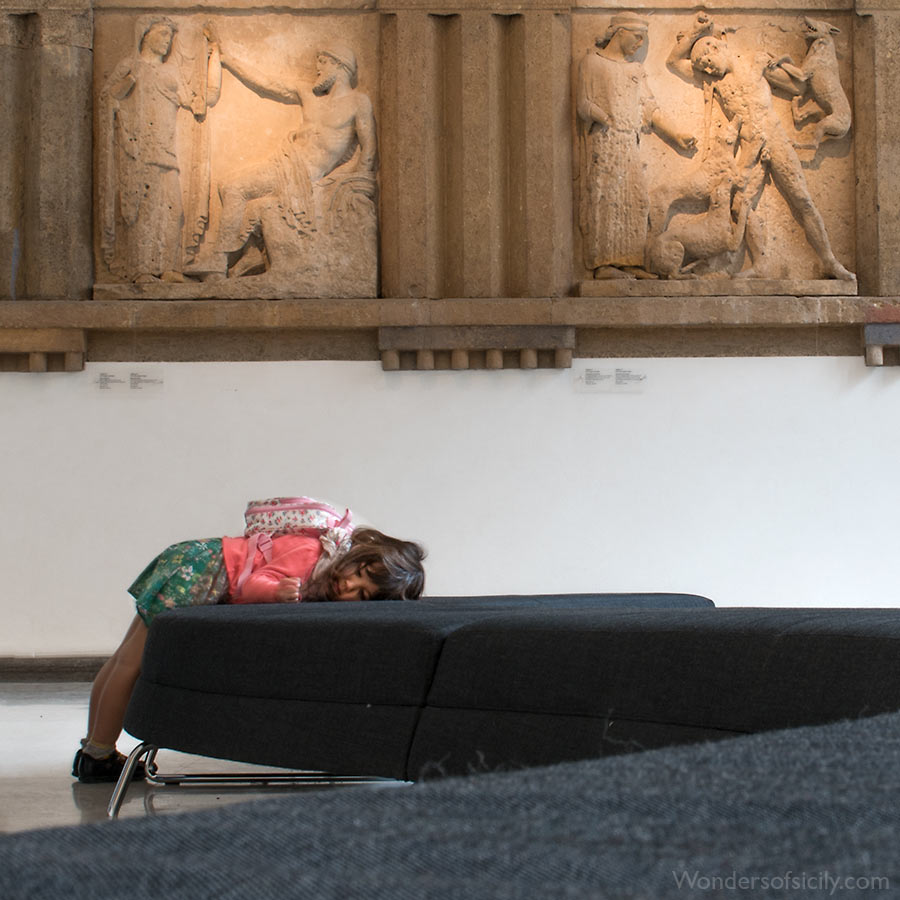
Boooooring...
The metopes in the background are from Temple E in Selinunte.
Safeguarding the museum’s contents during WWII
During the Second World War, the museum's director, Jole Bovio Marconi, took precautionary measures to safeguard the museum's contents by relocating them to the Abbey of San Martino delle Scale near Monreale. This action successfully protected the collection from destruction during the Allied invasion of Sicily. After the war, Bovio Marconi was tasked with the museum's reconstruction, with architect William De Angelis D'Ossat overseeing the restoration of the heavily damaged building.
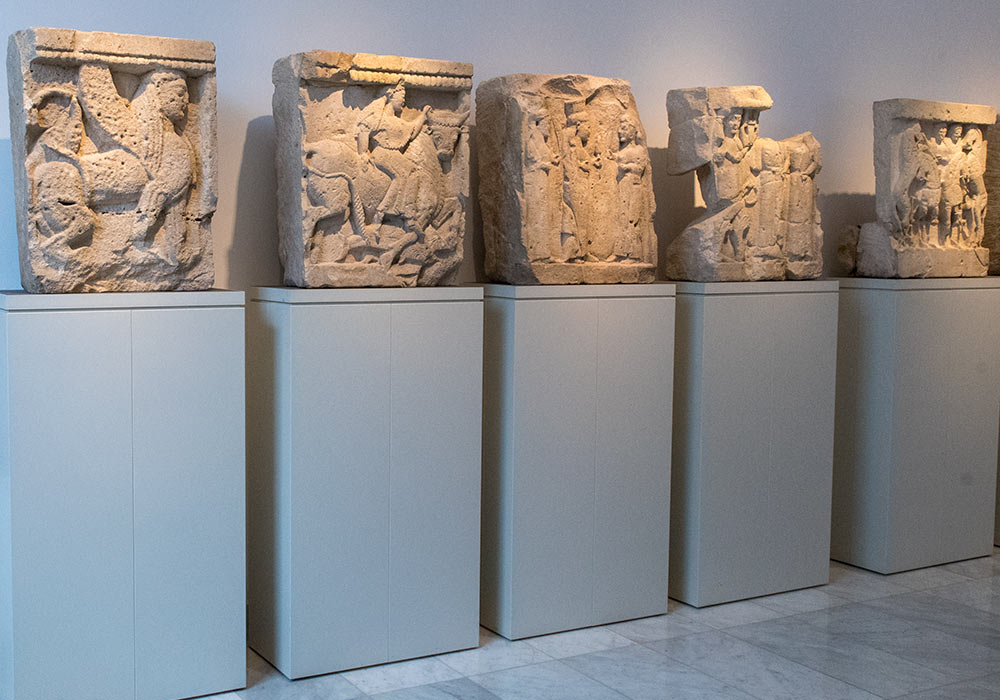
The small metopes. Selinunte, 560-550 BC.
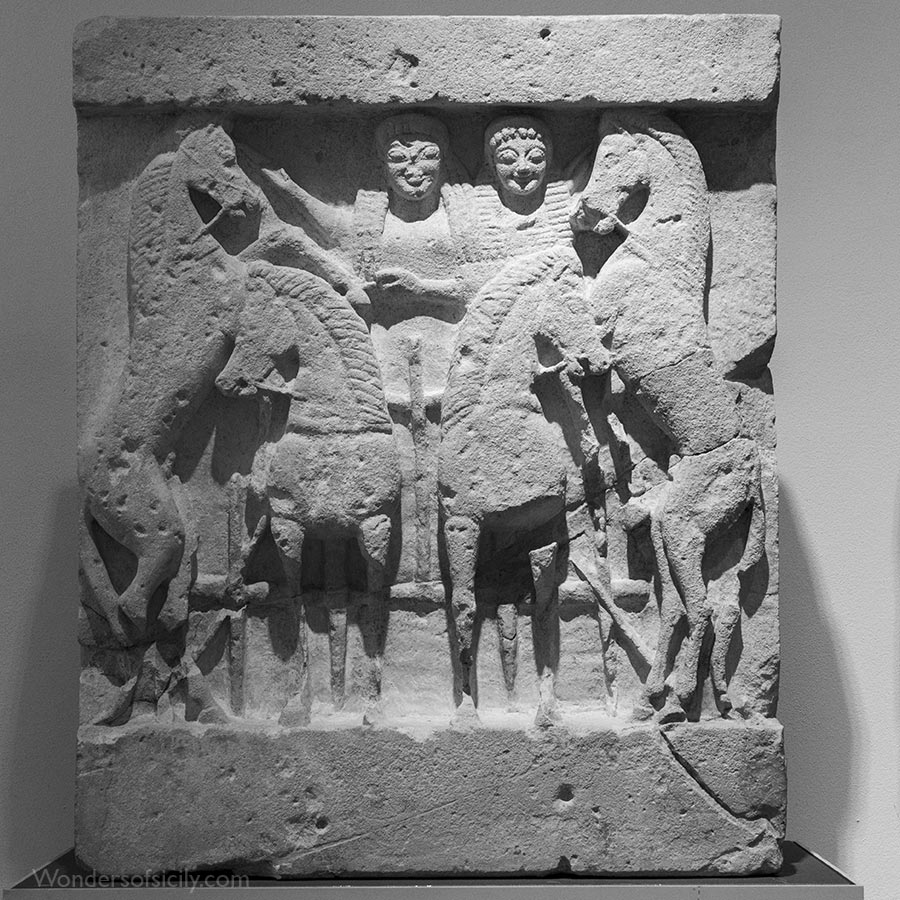
Small metope from Selinunte’s Temple Y.
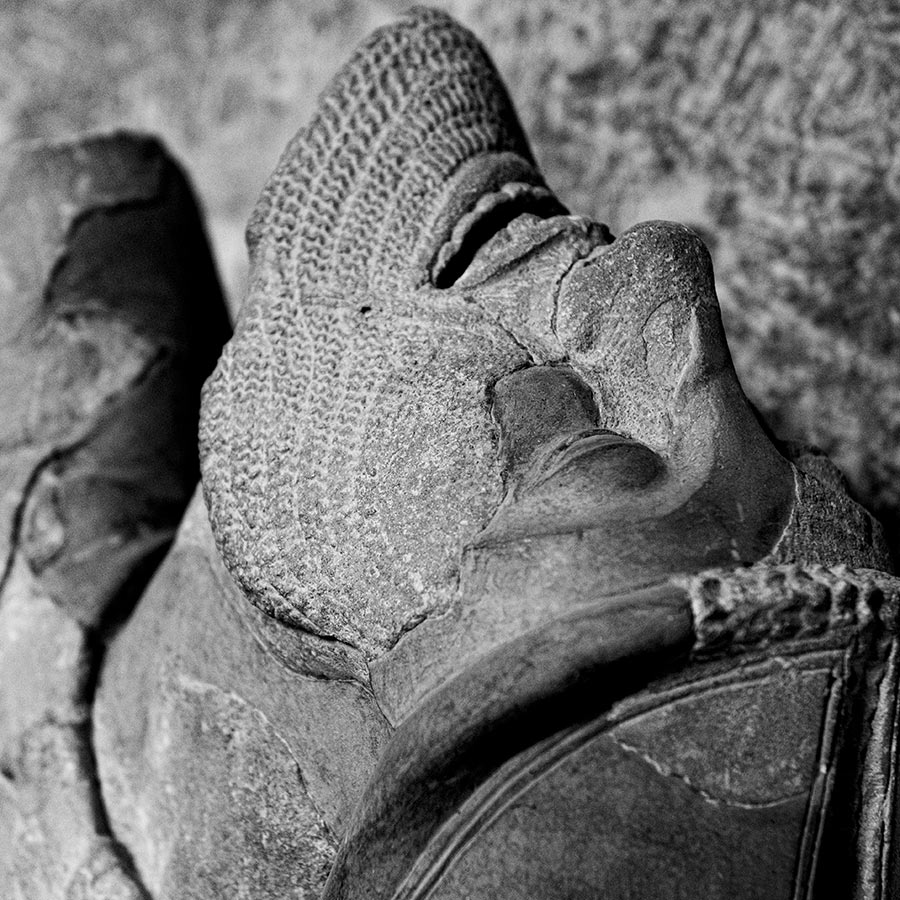
Dead warrior.
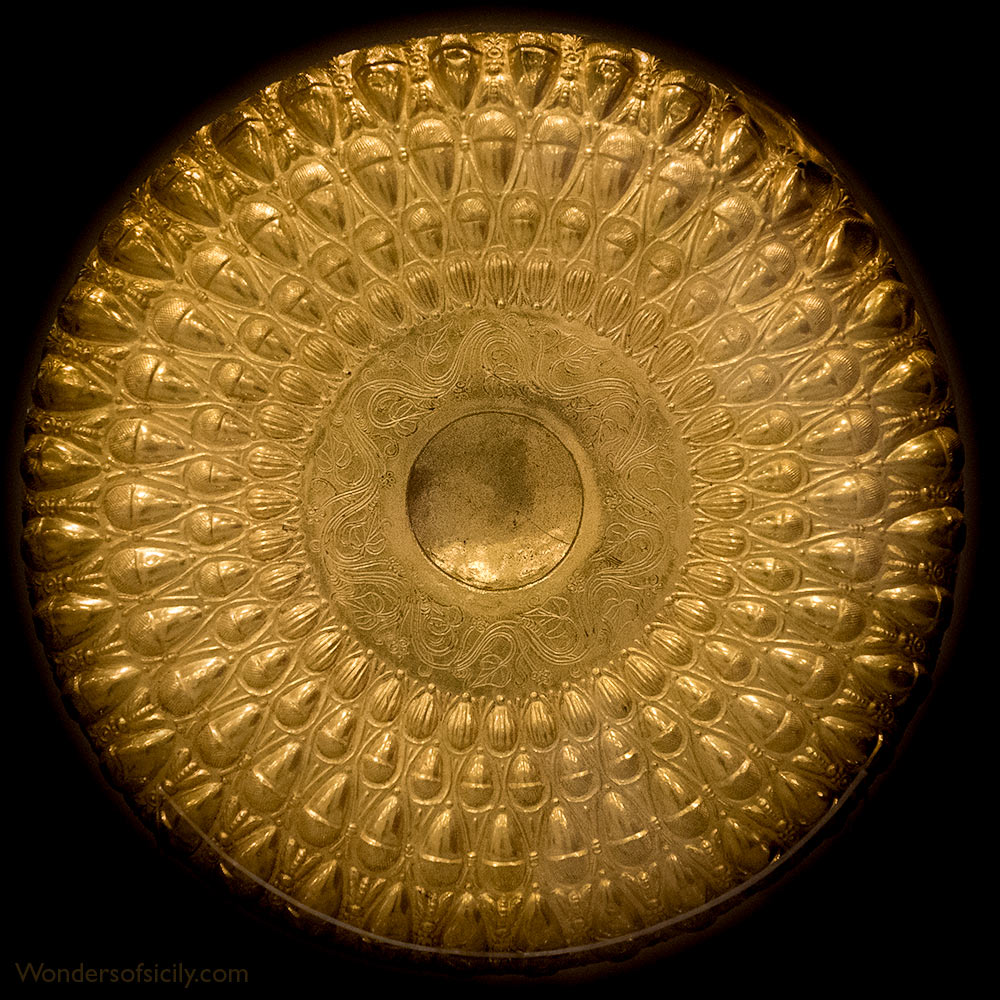
Phiale made of gold exhibited at the Regional Archeological Museum Antonio Salinas. A phiale is a libation bowl, used to pour wine onto an altar in sacrifice to the gods. Late 4th–early 3rd century b.c. Gold. Diameter 22.8 cm (9 in.); weight: 982.4 g (34.7 oz.). From near Caltavuturo. Himera. The rim is inscribed in stippled letters of the Greek alphabet with the words ΔΑΜΑΡΧΟΥ ΑΧΥΡΙΟΣ ΧΡΥΣΟΙΠΔΔ. Damarchos, son of Achyris.
The name phiale is known from Greek literary texts and from at least one inscription carved into an example of the form. ancient writers mention phialai decorated in various manners, both in gold and in silver. Very few gold phialai survive; we know of four other complete examples comparable in size, shape, and style to the one in the Palermo Archeological Museum. One of them is now at the Metropolitan Museum of Art in New York (see below). Information based on the article Ethnic Identity in Sicily: Greeks and Non-Greeks by Francesca Spatafora (in Sicily: Art and Invention between Greece and Rome). Photo: Per-Erik Skramstad
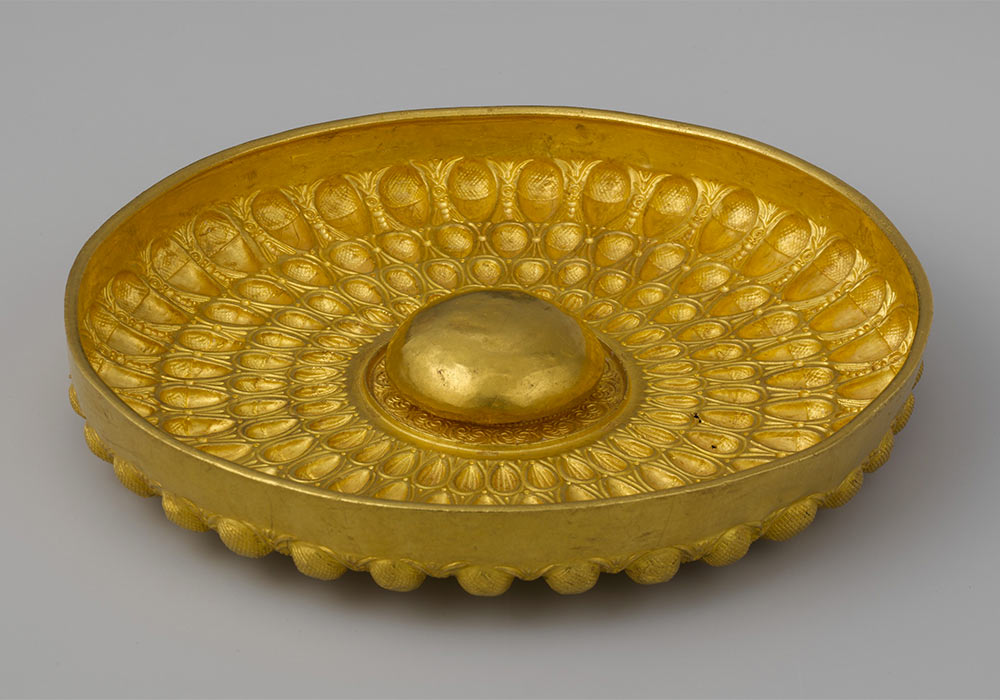
Phiale (not from Sicily, though) in Metropolitan Museum of Art in New York. It is very similar to the one in Palermo. This photo: Public Domain.
"If you want to understand ancient Greece, come to Sicily." (Douglas Sladen, 1901)
Segesta Agrigento Siracusa Taormina Selinunte Solunto Halaesa Arconidea Gela Netum / Neeton Centuripe
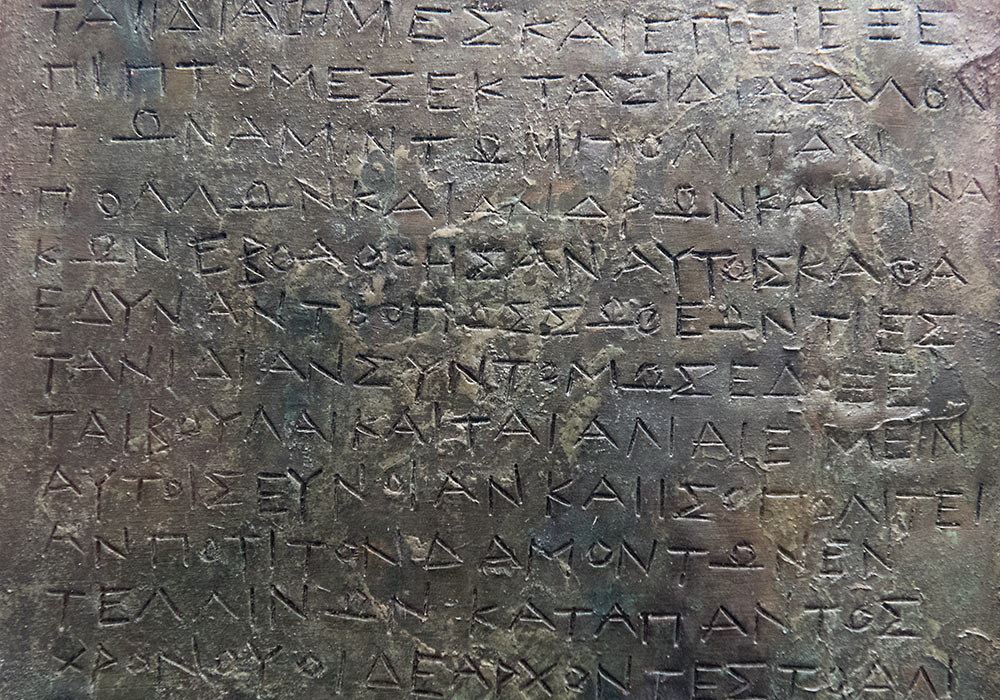
Decree (detail of a bronze tablet) by the Entellans in honour of the Segestans: «Under the archons Artemidoros, son of Eielos and Gnaios son of Oppios, in the first day of the month of Panamos. Since the Segestans have always been benevolent towards us, while we were in our land as well as after we were expelled from there, and when many of our people were captured, both men and women, they made their best endeavour to help them return safely to their city, it was decided by the council and the assembly that they shall enjoy forever the benevolence of the people of Entella as well as isopoliteia. The archons shall place this decree in the bouleterion after having it engraved on a bronze tablet.» (Archeological Museum, Palermo)
Agrigento Timeline
- 580 BC: Agrigento is founded as a colony of Gela and came to prominence under the tyrants Phalaris and Theron
- 480 BC: The artificial lake Kolymbetra was dug by Theron's Carthaginian prisoners taken at Himera
- 406 BC: The Carthaginians capture the city after an eight-month siege and burn the city
- 340 BC: Agrigento was rebuilt by Timoleon, who defeated the Carthaginians
- 261 BC: The Romans take the city
- 255 BC: Carthaginians recapture the city
- 218-201 BC Agrigento suffered badly during the Second Punic War when both Rome and Carthage fought to control it.
- 210 BC: The Romans take the city again, this time Agrigentum remained in their possession until the fall of the empire. Agrigentum remained a largely Greek-speaking community for centuries after the Roman conquest.
- After the fall of the Western Roman Empire, the city successively passed into the hands of the Vandalic Kingdom, the Ostrogothic Kingdom of Italy and then the Byzantine Empire. During this period the inhabitants of Agrigentum largely abandoned the lower parts of the city and moved to the former acropolis, at the top of the hill (this was probably related to the destructive coastal raids of the Saracens).
- Late 6th century: The Temple of Concord is converted into a church by the bishop of Agrigento, San Gregorio delle Rape (St Gregory of the Turnips)
- 828 AD: The Arabs take the city and make the trade flourish by cultivating cotton, sugar-cane and mulberries for the silk industry (they even had to make a new harbour, at Porto Empedocles)
- 1087: The Normans take Agrigento after a 116 days siege
- 1867: Luigi Pirandello was born
- 1885: The author Guy de Maupassant travels in Italy, Sicily included. After returning to Paris, Maupassant began publishing his Sicilian travel memoirs in installments in Le Figaro and Gil Blas
- 1927: Mussolini orders that the city should be called Agrigento, not Girgenti
- 1936: Luigi Pirandello dies
Sources: Wikipedia, The Blue Guide Sicily
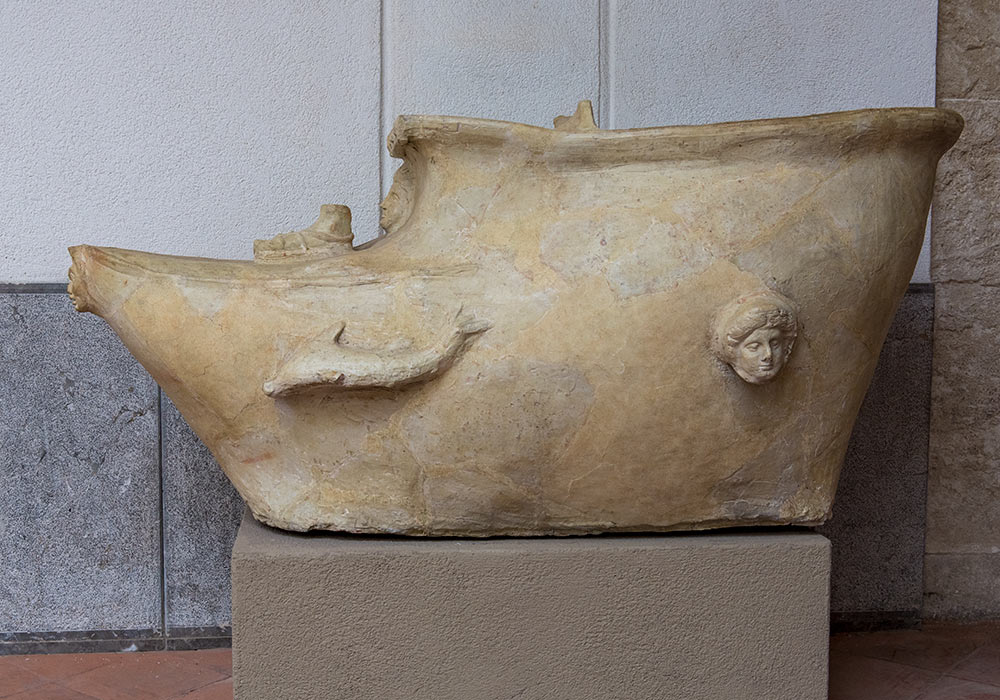
Bathtub slipper style (!) from Agrigento. I was made in the 2nd or 1st century BC.
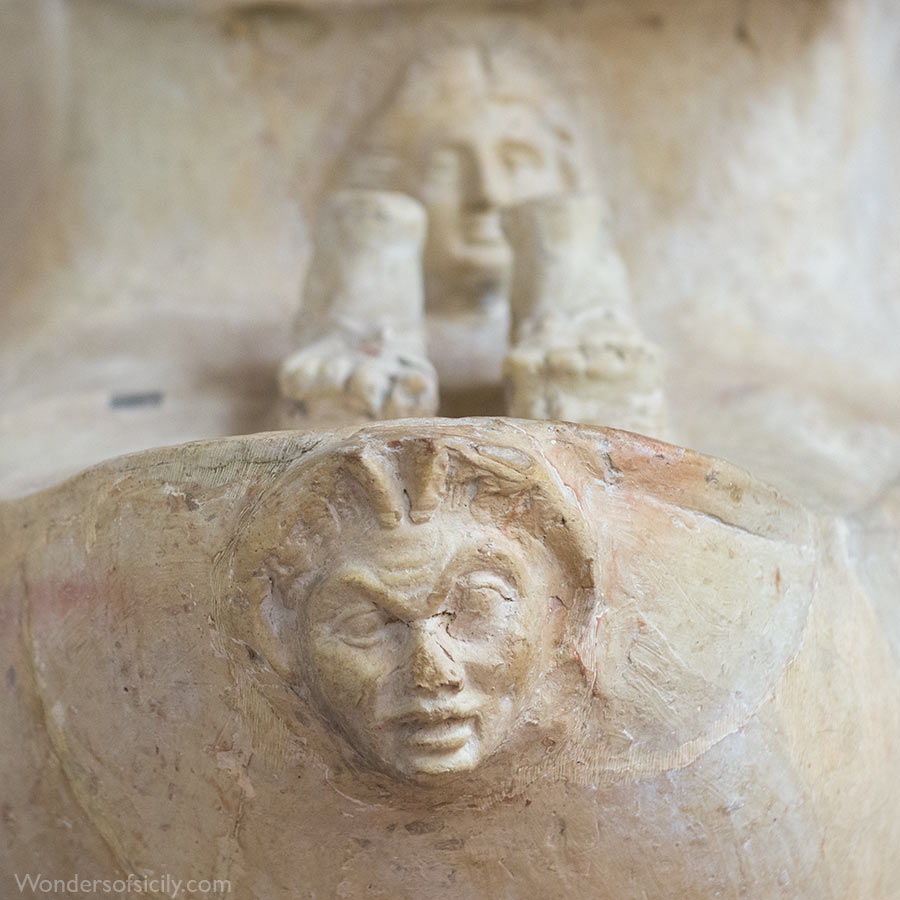
Details on a C2-C1 BC bathtub formed as a slipper (!).
Sicily: The Wonder of the Mediterranean (BBC documentary)
The museum houses a section dedicated to underwater artifacts, including items that were once part of ship cargoes, stone anchors, lead ingots, lamps, amphorae, and inscriptions spanning from Phoenician to Roman culture. The Phoenician section displays two large anthropomorphic sarcophagi from the fifth century BC, originating from the necropolis of Pizzo Cannita near modern Misilmeri. Additionally, it exhibits sculptures of gods and Phoenician votive stelae from Mozia and Lilybaeum.
The museum comprises private collections acquired or donated over the centuries, including the University Museum collection, obtained in 1814 from Giuseppe Emanuele Ventimiglia, Prince of Belmonte, who bequeathed it to the University of Palermo. Later, the university transferred the collection to the museum. The Antonino Salinas collection, the largest in the museum with 6,641 pieces, was left to the institution in 1914 and resulted in its renaming after Salinas. The collection includes books, manuscripts, prints, photographs, personal items, and approximately 6,000 coins. The Pietro Bonci Casuccini collection features Etruscan artifacts, such as sarcophagi, gravestones, urns, and Attic black and red-figure pottery, making it one of the most significant Etruscan collections outside of Tuscany. The exhibits were obtained from Chiusi as part of the excavations carried out in the estates of Count Pietro Bonci Casuccini.
Greek cities / Ancient settlements in Sicily
- Akragas (founded 580)
- Camarina (founded 589)
- Cozzo d'Apollo, near Comiso: ruins of a currently unidentified Greek settlement (see Blue Guide Sicily p 303)
- Egesta (Segesta)
- Entella
- Gela (founded 689)
- Halaesa (founded 403 BC by Archonides, dynastic ruler of Herbita). Also known as Halaesa Arconidea (Alesa Arconidea)
- Himera (founded 650)
- Katane (founded 729)
- Leontinoi (founded 730)
- Lipari (aka Aeolia)
- Megara Hyblea
- Mozia
- Mylae (Milazzo, founded 716)
- Naxos (founded 734)
- Panormus (aka Ziz, present day Palermo)
- Selinus (Selinunte) (founded c. 640)
- Siracusa (founded 734)
- Zancle (aka Messena, present day Messina)
- Ziz (aka Panormus, present day Palermo)
Sources
- Joseph F. Privitera: "Sicily: An Illustrated History"
- Sandra Benjamin: Sicily: Three Thousand Years of Human History
- Jeremy Dummett: Syracuse, City of Legends: A Glory of Sicily
- Jeremy Dummett: Palermo, City of Kings: The Heart of Sicily
- The Greek World (ed. G.P. Carratelli)
- The Blue Guide Sicily
- Goethe: Italian Journey
- Wagneropera.net
- Wikipedia
- More sources and recommended reading here
